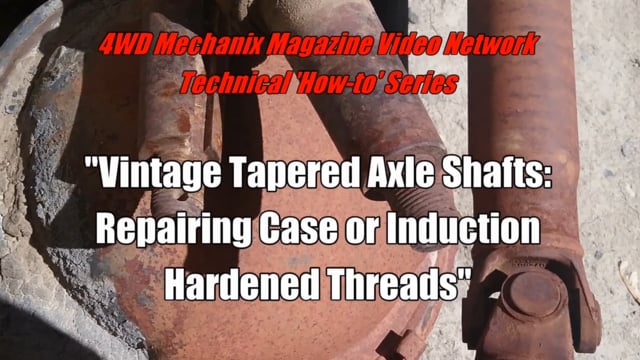Caution: Vintage tapered axle shaft threads are vulnerable. Unknowing techs and DIY enthusiasts often tension too hard with a puller or beat on the end of these axle shafts to remove the hub. This can damage the outer threads and will sometimes collapse the cotter pin hole. If another shaft is unavailable or obsolete, it may be possible to repair the end threads if the damage is no deeper than the cotter pin hole. This repair would be unsafe if the thread damage reaches beyond this. Any nut resistance or torque force must be at a safe, original section of the threads. In the repair shown in this video, the outer threads and cotter pin holes were damaged. Years ago, this damaged was caused by hub puller force. Despite the hardening of these shafts and threads, a puller had distorted the shaft end threads and cotter pin holes. Avoid this damage. See the videos on using an OTC 6574 puller with adapter plate (https://youtu.be/7VAat-0doao) and how to make an axle shaft end thread protector (https://youtu.be/vONQQ1HxB8w) for use during hub removal.
Tapered axle shaft threads are often ruined by improper use of force to remove a wheel hub and brake drum during brake and axle service work. Hub pullers are used to remove tapered rear axle hub/drum assemblies. Used improperly, a hub puller can crush the end of a tapered axle shaft and mushroom the cotter pin hole. In this how-to instructional video, see the steps necessary to restore threads and the cotter pin hole without impacting the heat treatment of surrounding metal.
Tapered axle shafts and hubs were popular on vintage Ford, Chrysler, Willys/Jeep®, Studebaker and other makes of automobiles and trucks. During axle shaft thread restoration, the goal is to preserve the OEM case or induction hardening (heat treatment). This begins with understanding the annealing and normalizing temperatures for the specific base metal and choosing the right braze filler. In this video, learn how to pre-test and post-test metals for heat treatment, hardness and integrity. Watch the careful manipulation of the oxy-acetylene torch to restore threads to original condition. The coverage ends with instructions for making a simple tool that can prevent this kind of thread damage when removing the hub/brake drum assembly from a tapered axle shaft.

This vintage axle shaft features a slightly protruding nose to protect the threads and cotter pin hole. Despite this design, the force of a conventional hub puller distorted the cotter pin hole. This damage is not into the threads, so careful re-drilling of the hole with a slightly undersized drill (11/64″ rather than the cotter pin’s size of 3/16″) could restore this shaft without the need for brazing. Glass bead blasting and careful thread chasing would follow.

By design, this axle shaft has an indexing hole at its end for centering the shaft during factory machining. This hole reaches the depth of the cotter pin cross-drilled hole, which weakens the shaft end. Excess puller stem force, applied directly to the thread end, will collapse this section of the shaft.

This is a popular 3-jaw OTC hub puller. The force applied with the spinner/hammer handle or by rapping on the puller’s stem end with a hefty hammer is enough to damage the thread section of the shaft. There is a remedy for this problem, an easy to make tool that protects the threads and redirects the puller force to the shoulder of the shaft. See the tool example at the end of the how-to HD video.

These axle shaft threads have no protective nose extension, which makes the threads even more vulnerable. Fortunately, the damage is limited to the cotter pin hole and fractures at the outer threads—these are non-load bearing areas of the axle shaft thread sections. Such damage can be repaired with a brazing process that includes Weld Mold Company’s 85-C filler rod. This kind of damage occurs when a hub puller’s stem overloads the end of the thread section. This shaft was damaged some time in the vehicle’s service history, during brake drum removal or axle work.

In the video, follow each step for repairing and restoring axle shaft threads and cotter pin holes. If the damage is in a non-load bearing section, the illustrated brazing method can produce a quality repair without impacting the heat treatment. The project depends upon use of correct braze filler, Thermo-Trap Paste, Tempilstik crayons, HRC hardness testing files plus unique handling of the oxy-acetylene torch to prevent loss of heat treatment and tensile strength.
Caution: Damage at the load bearing section of the threads would not be a candidate for brazing. Cracks or damage at the critical load bearing area would require: 1) normalizing the shaft section at a heat treating shop, 2) grinding, prepping and building up the thread section with a metallurgical match filler rod, using a fusion welding process (TIG/GTAW preferred for heat control, penetration and minimizing the HAZ); machining and re-threading the built up section; and finally 4) a trip back to the heat treating shop for re-heat treatment of the shaft to regain proper tensile and strength. Heating a heat treated axle shaft beyond its annealing temperature will soften the metal and drastically diminish its tensile strength, making the threads and shaft unsafe for use…Never fusion or resistance weld on heat treated metals; the metal will reach normalizing temperature within the weld and HAZ (heat affected zone), and the original heat treatment will be lost—dangerous cracking can result. Even when high tensile welding fill rod fuses with the base metal to become a high strength “weld nugget”, the original heat treatment has been reduced to low tensile, normalized metal in the HAZ.
For more details on Weld Mold Company’s 85-C braze filler rod and other niche products visit:

